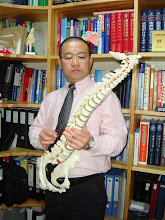Regular physical activity on a long-term basis has a particularly important role in maintaining healthy bones. Exercise can maintain and increase bone strength by increasing bone mass or by slowing age-related bone loss. Muscle strength is also increased, which is important for supporting the joints and preventing falls.
Exercise has also been shown to improve co-ordination and balance, which helps to prevent falls and to improve general physical health and well-being.
Be aware that any positive gains in bone strength are lost when you stop exercising, so that it is important that your exercise is regular and ongoing.
Caution: Someone who has established osteoporosis (one or more fractures) may not be able to do as many types of activities as someone without osteoporosis. Talk to your doctor and physiotherapist about activities you can do.
Exercise helps to build and maintain strong bones, prevent falls and fractures and speed rehabilitation.
______________________________________________
Physical Activity at Different Ages and Stages
Childhood /Adolescence
Bone status:In girls, the major build up of bone occurs in the pre-teen years. Lifetime Peak Bone Density is reached during mid to late 20s.Effect of exercise at this age:Maximises peak bone density, which helps keep bones strong for longer in adulthood.
Early to Middle Adulthood
Bone status:Bone loss starts to occur very gradually when a person reaches their thirties, although increases in bone density are still possible during middle adulthood. In women from 45 years on, bone loss begins to increase to 1- 2% per year.Effect of exercise at this age:Maintains bone strength by helping to slow bone loss, plus improve muscle strength, heart and lung fitness.
Postmenopausal Women
Bone status:
Bone loss speeds up to 2-4% per year at the onset of menopause.Effect of exercise at this age:Can maintain bone strength by helping to slow the rate of bone loss following menopause.
Men
Bone status:Generally bone density tends to remain constant until later in life. Low testosterone or hypogonadism can cause bone loss similar to postmenopausal women.Effect of exercise at this age:Improvements in muscular strength, balance and coordination to help prevent falls and maintain general health. Testosterone combined with exercise may be beneficial for bone in men with hypogonadism.
Older Adults without osteoporosis
Bone status:After 75 years of age further increases in bone loss occur in both sexes, especially from the neck of the femur (thigh bone). The risk of fracture increases as bone loss increases.Effect of exercise at this age:Helps to maintain bone strength and increase muscle strength, balance and co-ordination, which in turn help to prevent falls.
Older Adults with Osteoporosis/Fractures:
Bone status:Bones are increasingly thinner and brittle.Effect of exercise at this age:Exercises recommended by physiotherapists can improve general health, strength, balance and posture to prevent falls.
Exercises for bone health:
(assumes you don't have osteoporosis, otherwise see section below on exercise if you have osteoporosis)
There are two main types of exercises that are beneficial to bone health:
Weight-bearing exercise Resistance exercise (lifting weights with arms or legs)
Weight bearing exercise
Weight-bearing exercise means any exercise that is done while you are on your feet, so that gravity is exerting a force.
Your bones become stronger when they bear weight during exercise and when some amount of 'impact' or extra strain is placed on those bones.
If the 'strain' level is too low, then the bone will not become stronger and may still lose mass. Too much 'strain' could result in injury. The best 'strain' is from activities that may be new to your body, which means your bones are getting a variety of forces and loads on them.
______________________________
Exercise: if you have osteoporosis
If you have been diagnosed with osteoporosis and/or have already had a fracture, you should see your doctor or physiotherapist about starting an individual exercise program.
Your aim is to maintain bone strength and reduce the risk of fractures and falls by improving posture, balance and muscular strength.
Because of the higher risk of fracture, exercising at a level high enough to produce stress on the bones is not recommended.
Appropriate exercises include Tai Chi for balance, flexibility and muscle strength, gentle weights for muscle strength, water-based exercises (hydrotherapy) and walking.
Avoid high impact activities (eg running).
Avoid jarring & twisting movements (eg golf swing).
Avoid heavy lifting and lifting objects some distance from your body (eg picking up grandchildren).
Avoid abdominal curls (sit-ups).
Avoid bending forward from the waist.
Avoid sudden, abrupt movements.
Don't overdo it (especially if you have not done any activity for many years).
Part 1/3: Discovering the Microsoft Surface Pro
-
Part 2: Does Microsoft know what they've got with this thing?
Part 3: The (possible) future of medicine, and the Microsoft Surface Pro
*What makes you so ...
11 年前








没有评论:
发表评论